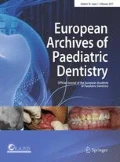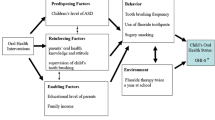Abstract
Aim
To improve the oral health of children and teenagers with autism spectrum disorder (ASD) by using an iPad®-based training programme.
Methods
Fifty-two children and teenagers with ASD (aged 3–19 years) educated in schools or in care centres participated in this cohort study and followed for 8 months. A training programme for teaching toothbrushing behaviours was proposed to the educational staff. Quotation grids enabled assessment of the programme’s efficacy.
Results
Showed an improvement in toothbrushing. The children’s autonomy increased and oral care was more easily implemented when steps were taken by the caregivers. Wilcoxon analysis showed significant improvement in each variable related to toothbrushing.
Conclusions
The iPad® is an attractive and easy device for people with ASD to use. Its use in a training programme for teaching toothbrushing behaviours was efficient.



Similar content being viewed by others
References
American Academy of Pediatric Dentistry. Guideline on caries-risk assessment and management for infants, children, and adolescents. Pediatr Dent. 2013;35:E157–64.
American Psychiatric Association. Diagnostic and statistical manual of mental disorders. 5th edn. Washington: American Psychiatric Publishing; 2013.
Ash ES. Forming Impressions of Personality. J Abnorm Soc Psychol. 1946;41:258–90.
Asma’a MS, Badr SB, Rashed MA. Effectiveness of audiovisual modeling on the behavioral change toward oral and dental care in children with autism. Indian J Dent. 2013;4:184–90.
Bandura A. Self-efficacy: toward a unifying theory of behavioral change. Psychol Rev. 1977;84:191.
Baranek GT, Boyd BA, Poe MD, et al. Hyperresponsive sensory patterns in young children with autism, developmental delay, and typical development. Am J Ment Retard. 2007;112:233–45.
Baron-Cohen S, Ashwin E, Ashwin C, et al. Talent in autism: hyper-systemising, hyper-attention to detail and sensory hypersensitivity. Philos Trans R Soc Lond B Biol Sci. 2009;364:1377–83.
Bishop MR, Kenzer AL, Coffman CM, et al. Using stimulus fading without escape extinction to increase compliance with toothbrushing in children with autism. Res Autism Spec Disord. 2013;7:680–6.
Brickhouse TH, Farrington FH, Best AM, Ellsworth CW. Barriers to dental care for children in Virginia with autism spectrum disorders. J Dent Child (Chic). 2009;76:188–93.
Campbell RL, Richie DM. Problems in the theory of developmental sequences. Hum Dev. 1983;26:156–72.
Delli K, Reichart PA, Bornstein MM, Livas C. Management of children with autism spectrum disorder in the dental setting: concerns, behavioural approaches and recommendations. Med Oral Patol Oral Cir Bucal. 2013;18:e862.
Dias GG, Prado EF, Vadasz E, Siqueira JTT. Evaluation of the efficacy of a dental plaque control program in autistic patients. J Autism Dev Disord. 2010;40:704–8.
Gandhi RP, Klein U. Autism spectrum disorders: an update on oral health management. J Evid Based Dent Pract. 2014;14:115–26.
Hernandez P, Ikkanda Z. Applied behavior analysis: behavior management of children with autism spectrum disorders in dental environments. J Am Dent Assoc. 2011;142:281–7.
Jaber MA. Dental caries experience, oral health status and treatment needs of dental patients with autism. J Appl Oral Sci. 2011;19:212–7.
Kagohara DM, van der Meer L, Ramdoss, et al. Using iPods® and iPads® in teaching programs for individuals with developmental disabilities: a systematic review. Res Dev Disabil. 2013;34:147–56.
Kemp F. Alternatives: a review of non-pharmacologic approaches to increasing the cooperation of patients with special needs to inherently unpleasant dental procedures. Behav Anal Today. 2005;6:88.
Knight V, Sartini E, Spriggs AD. Evaluating visual activity schedules as evidence-based practice for individuals with autism spectrum disorders. J Autism Dev Disord. 2015;45:157–78.
Koyama T, Wang HT. Use of activity schedule to promote independent performance of individuals with autism and other intellectual disabilities: a review. Res Dev Disabil. 2011;32:2235–42.
Lai B, Milano M, Roberts MW, Hooper SR. Unmet dental needs and barriers to dental care among children with autism spectrum disorders. J Autism Dev Disord. 2012;42:1294–303.
Lewis C, Vigo L, Novak L, Klein EJ. Listening to parents: a qualitative look at the dental and oral care experiences of children with autism spectrum disorder. Pediatr Dent. 2015;37:98E–104E.
Loo CY, Graham RM, Hughes CV. Behaviour guidance in dental treatment of patients with autism spectrum disorder. Int J Paediatr Dent. 2009;19:390–8.
Marshall J, Sheller B, Mancl L. Caries-risk assessment and caries status of children with autism. Pediatr Dent. 2010;32:69–75.
Mercier C, Bourdon P, Bourdet JF. The time of the child with autism and the time of the professional: adopt the rhythm of the learner in order to facilitate the access to new learning. Distances et médiations des savoirs. Distance Mediat Knowl. 2016;16. (French).
Nelson TM, Sheller B, Friedman CS, et al. Educational and therapeutic behavioral approaches to providing dental care for patients with autism spectrum disorder. Spec Care Dent. 2015;35:105–13.
Pilebro C, Bäckman B. Teaching oral hygiene to children with autism. Int J Paediatr Dent. 2005;15:1–9.
Popple B, Wall C, Flink L, et al. Brief report: remotely delivered video modeling for improving oral hygiene in children with ASD: a pilot study. J Autism Dev Disord. 2016;46:2791–6.
Stein LI, Polido JC, Najera SOL, Cermak SA. Oral care experiences and challenges in children with autism spectrum disorders. Pediat Dent. 2012;34:387–91.
Stein LI, Polido JC, Cermak SA. Oral care and sensory over-responsivity in children with autism spectrum disorders. Pediatr Dent. 2013;35:230–5.
Udhya J, Varadharaja MM, Parthiban J. Autism disorder (AD): an updated review for paediatric dentists. J Clin Diagn Res. 2014;8:275.
Weil TN, Inglehart MR. Three-to 21-year-old patients with autism spectrum disorders: parents’ perceptions of severity of symptoms, oral health and oral health-related behavior. Pediatr Dent. 2012;34:473–9.
Acknowledgements
This study was supported by grants from the International Foundation of Applied Disability Research (FIRAH). We would like to express our gratitude to the çATED-autisme team. The authors would like to thank children, parents and professionals who participated to the “çATED pour tes dents” programme.
Author information
Authors and Affiliations
Corresponding author
Ethics declarations
Conflict of interest
The authors declare that they have no conflicts of interest.
Ethical approval
All procedures performed in this study involving human participants were in accordance with the ethical standards of the institutional and/or national research committee and with the 1964 Helsinki Declaration and its later amendments or comparable ethical standards.
Informed consent
For this study, written informed consent was obtained from all parents of children and adolescents included in the study.
Additional information
Publisher’s Note
Springer Nature remains neutral with regard to jurisdictional claims in published maps and institutional affiliations.
Rights and permissions
About this article
Cite this article
Lopez Cazaux, S., Lefer, G., Rouches, A. et al. Toothbrushing training programme using an iPad® for children and adolescents with autism. Eur Arch Paediatr Dent 20, 277–284 (2019). https://doi.org/10.1007/s40368-018-0396-y
Received:
Accepted:
Published:
Issue Date:
DOI: https://doi.org/10.1007/s40368-018-0396-y




